Business Documents: Cash Book and Letter of Demand
VerifiedAdded on 2023/01/20
|15
|2616
|62
AI Summary
This document provides information about cash book and letter of demand in business documents. It explains the types of cashbook, advantages of cashbook, and performa of cash book. It also discusses the advantages of sending a letter of demand and provides its performa. The document also covers topics like appropriate technology and software application, layout and style of publication, elements of document design, format and style, organizational requirements, memorandums and emails, letters, efficient entry of information, functions to ensure consistency of design and layout, input devices, consequences, checks, storing a document, document design and production, benefits of proofreading, modification, naming and saving, and printing document.
Contribute Materials
Your contribution can guide someone’s learning journey. Share your
documents today.
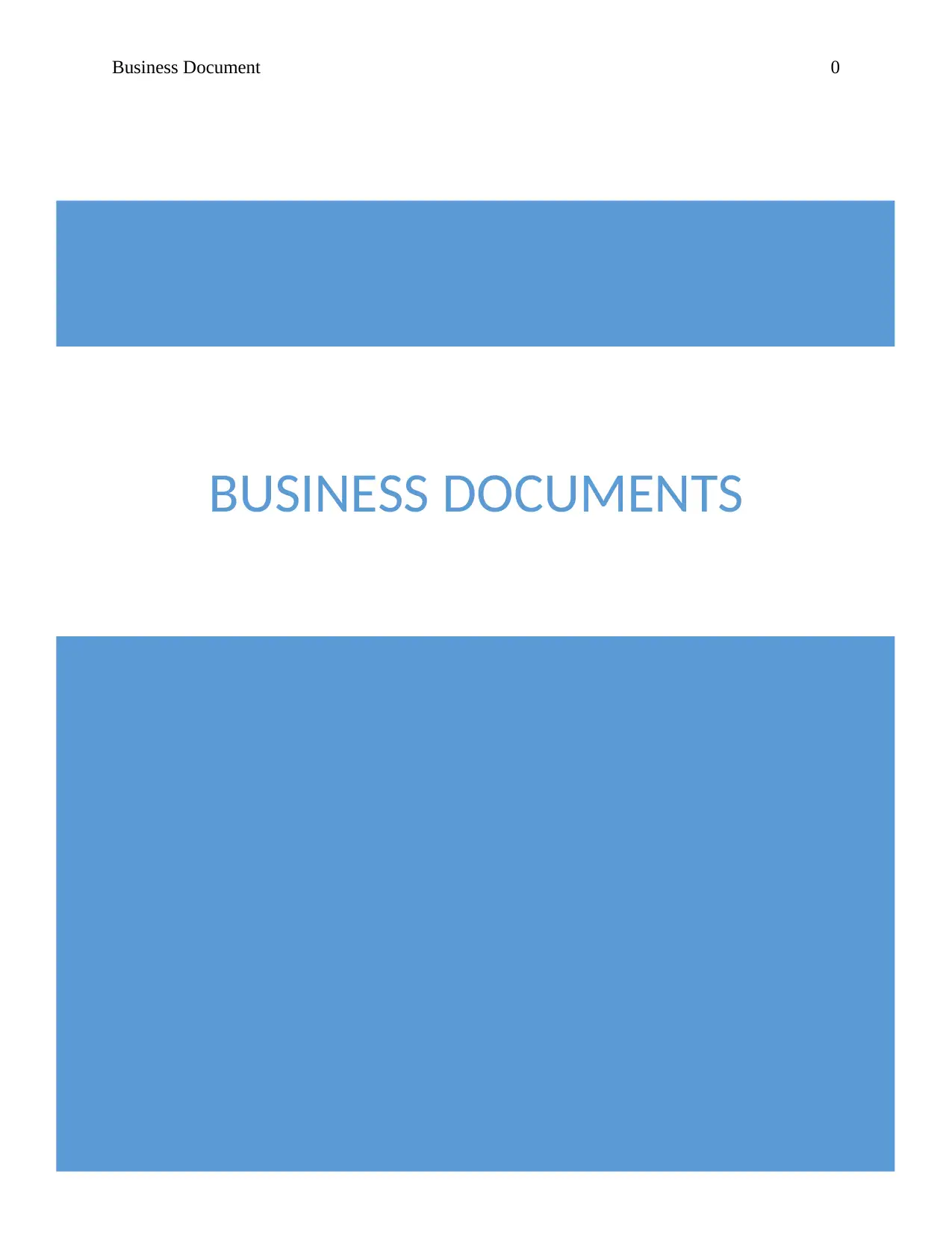
BUSINESS DOCUMENTS
Business Document 0
Business Document 0
Secure Best Marks with AI Grader
Need help grading? Try our AI Grader for instant feedback on your assignments.
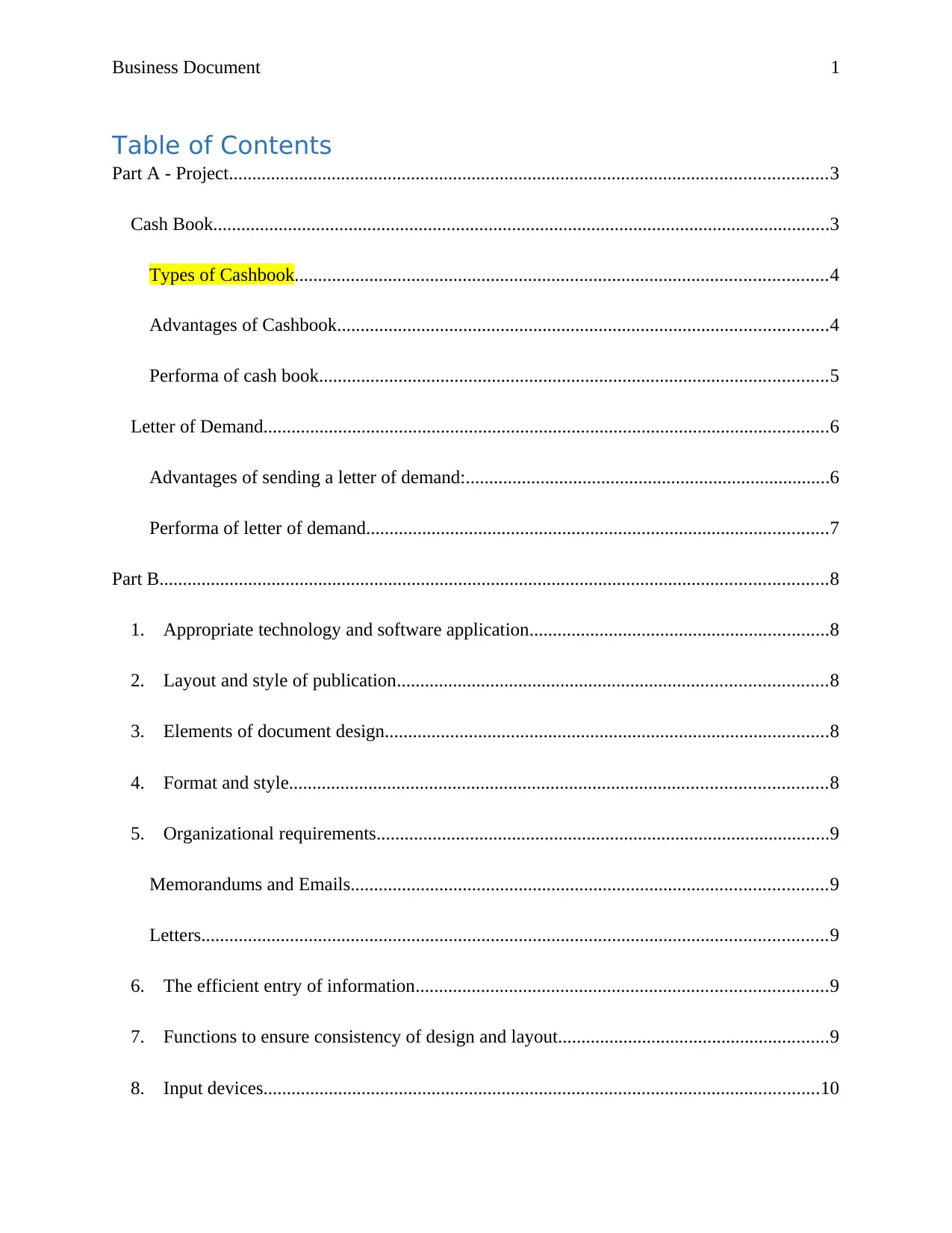
Business Document 1
Table of Contents
Part A - Project................................................................................................................................3
Cash Book....................................................................................................................................3
Types of Cashbook..................................................................................................................4
Advantages of Cashbook.........................................................................................................4
Performa of cash book.............................................................................................................5
Letter of Demand.........................................................................................................................6
Advantages of sending a letter of demand:..............................................................................6
Performa of letter of demand...................................................................................................7
Part B...............................................................................................................................................8
1. Appropriate technology and software application................................................................8
2. Layout and style of publication............................................................................................8
3. Elements of document design...............................................................................................8
4. Format and style...................................................................................................................8
5. Organizational requirements.................................................................................................9
Memorandums and Emails......................................................................................................9
Letters......................................................................................................................................9
6. The efficient entry of information........................................................................................9
7. Functions to ensure consistency of design and layout..........................................................9
8. Input devices.......................................................................................................................10
Table of Contents
Part A - Project................................................................................................................................3
Cash Book....................................................................................................................................3
Types of Cashbook..................................................................................................................4
Advantages of Cashbook.........................................................................................................4
Performa of cash book.............................................................................................................5
Letter of Demand.........................................................................................................................6
Advantages of sending a letter of demand:..............................................................................6
Performa of letter of demand...................................................................................................7
Part B...............................................................................................................................................8
1. Appropriate technology and software application................................................................8
2. Layout and style of publication............................................................................................8
3. Elements of document design...............................................................................................8
4. Format and style...................................................................................................................8
5. Organizational requirements.................................................................................................9
Memorandums and Emails......................................................................................................9
Letters......................................................................................................................................9
6. The efficient entry of information........................................................................................9
7. Functions to ensure consistency of design and layout..........................................................9
8. Input devices.......................................................................................................................10

Business Document 2
Keyboard................................................................................................................................10
Mouse....................................................................................................................................10
Scanner..................................................................................................................................10
9. Consequences.....................................................................................................................10
10. Checks.............................................................................................................................11
11. Store a document.............................................................................................................11
12. Document design and production...................................................................................11
13. Benefits of proofreading.................................................................................................11
14. Modification....................................................................................................................12
15. Naming and saving..........................................................................................................12
16. Printing document...........................................................................................................12
References......................................................................................................................................13
Keyboard................................................................................................................................10
Mouse....................................................................................................................................10
Scanner..................................................................................................................................10
9. Consequences.....................................................................................................................10
10. Checks.............................................................................................................................11
11. Store a document.............................................................................................................11
12. Document design and production...................................................................................11
13. Benefits of proofreading.................................................................................................11
14. Modification....................................................................................................................12
15. Naming and saving..........................................................................................................12
16. Printing document...........................................................................................................12
References......................................................................................................................................13
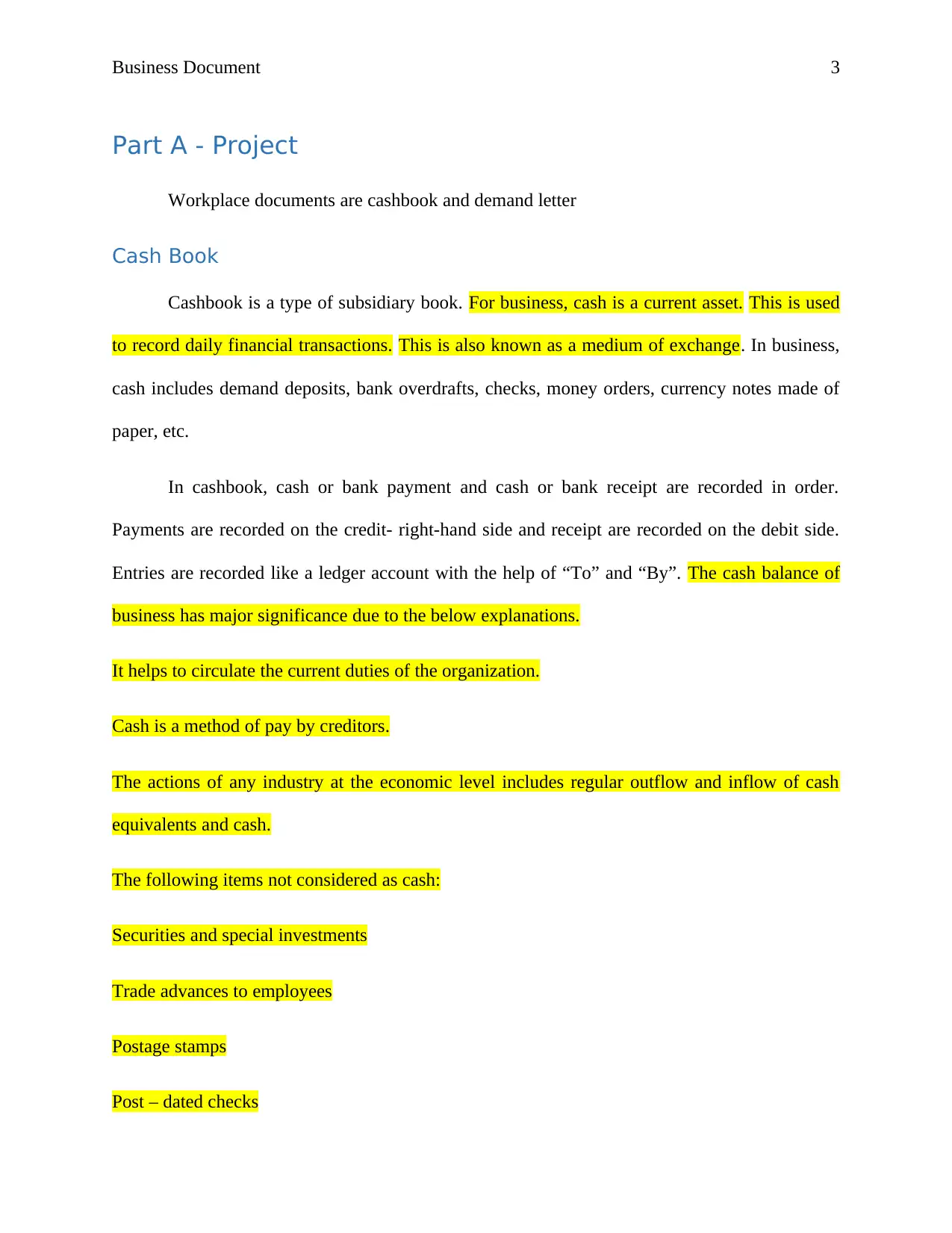
Business Document 3
Part A - Project
Workplace documents are cashbook and demand letter
Cash Book
Cashbook is a type of subsidiary book. For business, cash is a current asset. This is used
to record daily financial transactions. This is also known as a medium of exchange. In business,
cash includes demand deposits, bank overdrafts, checks, money orders, currency notes made of
paper, etc.
In cashbook, cash or bank payment and cash or bank receipt are recorded in order.
Payments are recorded on the credit- right-hand side and receipt are recorded on the debit side.
Entries are recorded like a ledger account with the help of “To” and “By”. The cash balance of
business has major significance due to the below explanations.
It helps to circulate the current duties of the organization.
Cash is a method of pay by creditors.
The actions of any industry at the economic level includes regular outflow and inflow of cash
equivalents and cash.
The following items not considered as cash:
Securities and special investments
Trade advances to employees
Postage stamps
Post – dated checks
Part A - Project
Workplace documents are cashbook and demand letter
Cash Book
Cashbook is a type of subsidiary book. For business, cash is a current asset. This is used
to record daily financial transactions. This is also known as a medium of exchange. In business,
cash includes demand deposits, bank overdrafts, checks, money orders, currency notes made of
paper, etc.
In cashbook, cash or bank payment and cash or bank receipt are recorded in order.
Payments are recorded on the credit- right-hand side and receipt are recorded on the debit side.
Entries are recorded like a ledger account with the help of “To” and “By”. The cash balance of
business has major significance due to the below explanations.
It helps to circulate the current duties of the organization.
Cash is a method of pay by creditors.
The actions of any industry at the economic level includes regular outflow and inflow of cash
equivalents and cash.
The following items not considered as cash:
Securities and special investments
Trade advances to employees
Postage stamps
Post – dated checks
Paraphrase This Document
Need a fresh take? Get an instant paraphrase of this document with our AI Paraphraser
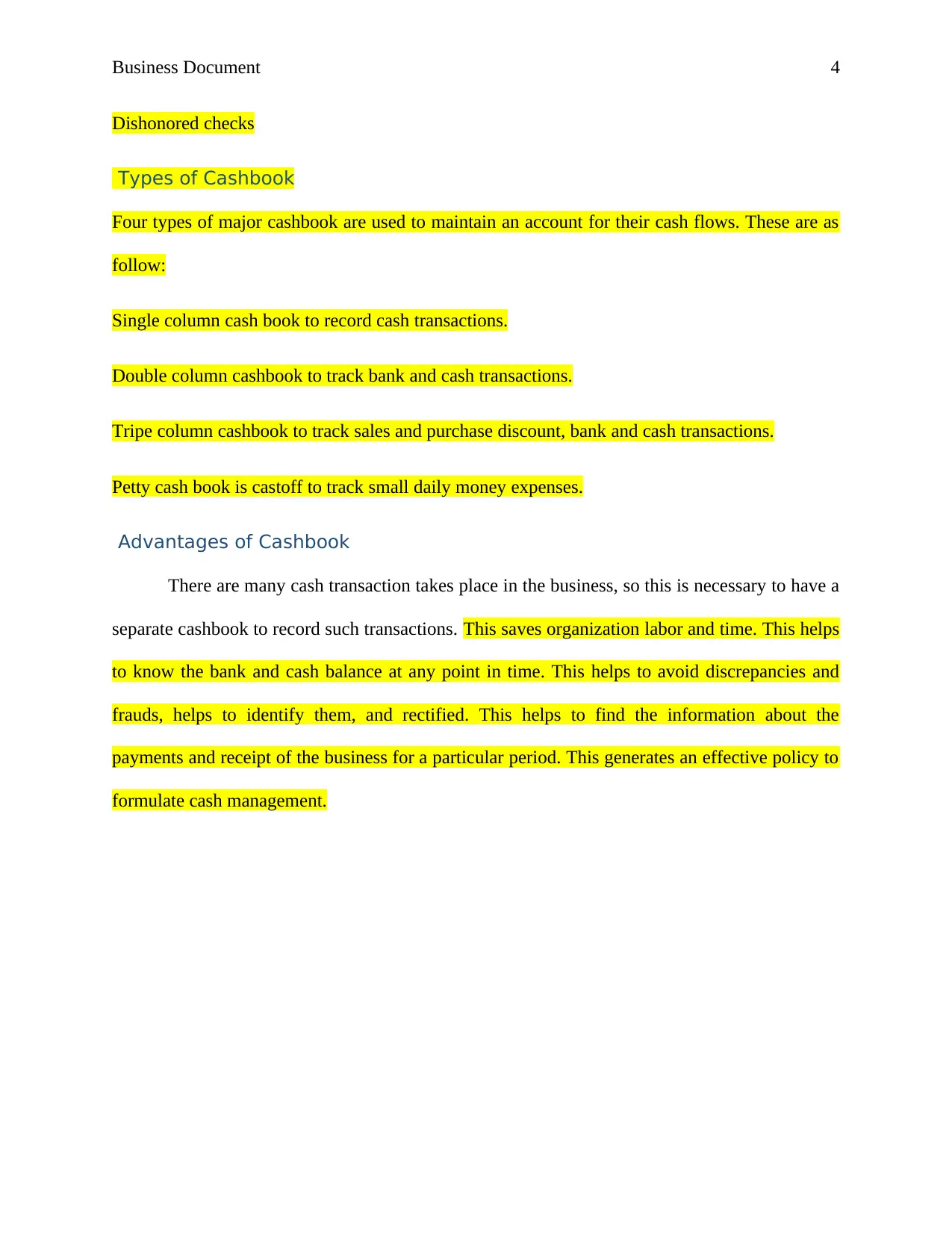
Business Document 4
Dishonored checks
Types of Cashbook
Four types of major cashbook are used to maintain an account for their cash flows. These are as
follow:
Single column cash book to record cash transactions.
Double column cashbook to track bank and cash transactions.
Tripe column cashbook to track sales and purchase discount, bank and cash transactions.
Petty cash book is castoff to track small daily money expenses.
Advantages of Cashbook
There are many cash transaction takes place in the business, so this is necessary to have a
separate cashbook to record such transactions. This saves organization labor and time. This helps
to know the bank and cash balance at any point in time. This helps to avoid discrepancies and
frauds, helps to identify them, and rectified. This helps to find the information about the
payments and receipt of the business for a particular period. This generates an effective policy to
formulate cash management.
Dishonored checks
Types of Cashbook
Four types of major cashbook are used to maintain an account for their cash flows. These are as
follow:
Single column cash book to record cash transactions.
Double column cashbook to track bank and cash transactions.
Tripe column cashbook to track sales and purchase discount, bank and cash transactions.
Petty cash book is castoff to track small daily money expenses.
Advantages of Cashbook
There are many cash transaction takes place in the business, so this is necessary to have a
separate cashbook to record such transactions. This saves organization labor and time. This helps
to know the bank and cash balance at any point in time. This helps to avoid discrepancies and
frauds, helps to identify them, and rectified. This helps to find the information about the
payments and receipt of the business for a particular period. This generates an effective policy to
formulate cash management.
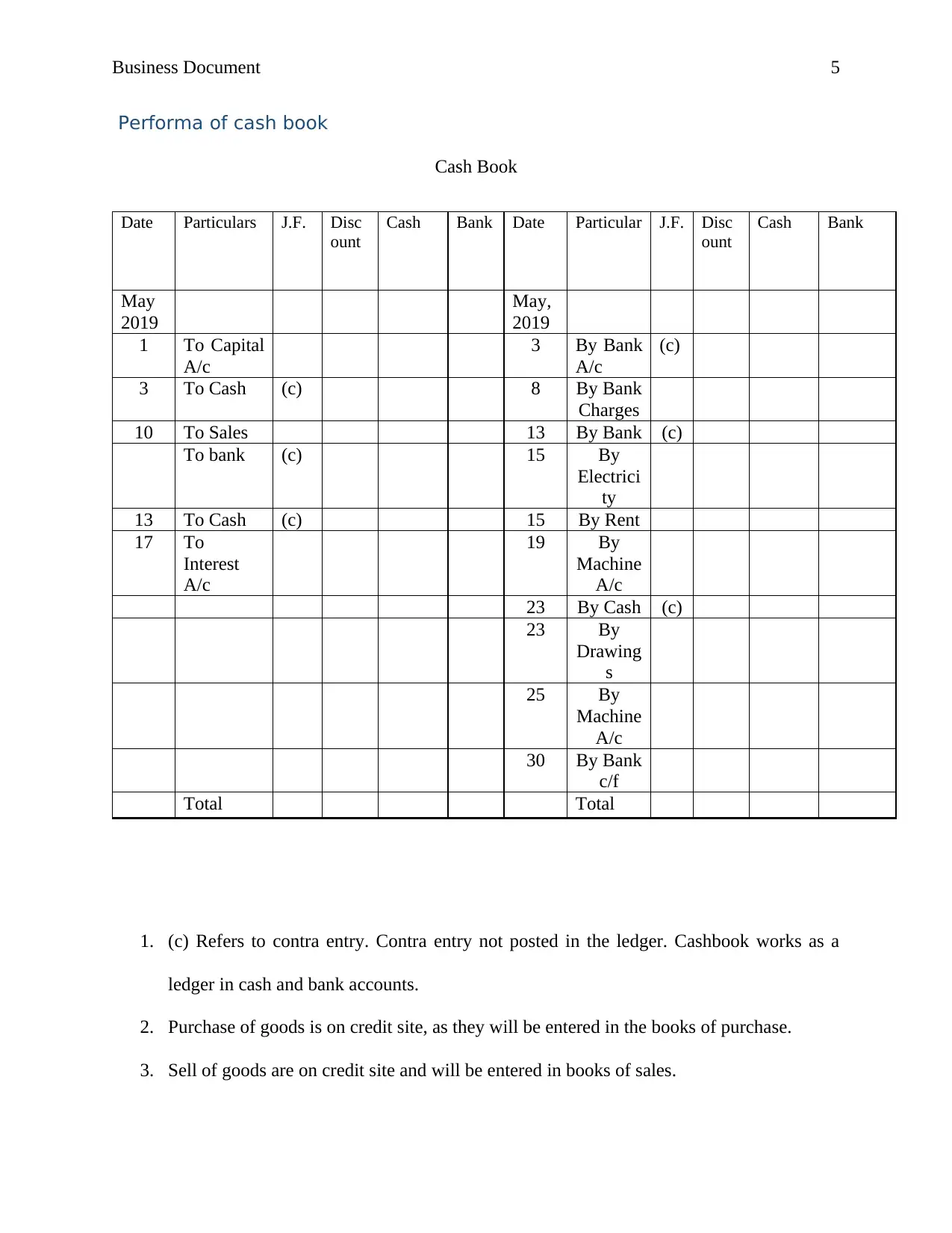
Business Document 5
Performa of cash book
Cash Book
Date Particulars J.F. Disc
ount
Cash Bank Date Particular J.F. Disc
ount
Cash Bank
May
2019
May,
2019
1 To Capital
A/c
3 By Bank
A/c
(c)
3 To Cash (c) 8 By Bank
Charges
10 To Sales 13 By Bank (c)
To bank (c) 15 By
Electrici
ty
13 To Cash (c) 15 By Rent
17 To
Interest
A/c
19 By
Machine
A/c
23 By Cash (c)
23 By
Drawing
s
25 By
Machine
A/c
30 By Bank
c/f
Total Total
1. (c) Refers to contra entry. Contra entry not posted in the ledger. Cashbook works as a
ledger in cash and bank accounts.
2. Purchase of goods is on credit site, as they will be entered in the books of purchase.
3. Sell of goods are on credit site and will be entered in books of sales.
Performa of cash book
Cash Book
Date Particulars J.F. Disc
ount
Cash Bank Date Particular J.F. Disc
ount
Cash Bank
May
2019
May,
2019
1 To Capital
A/c
3 By Bank
A/c
(c)
3 To Cash (c) 8 By Bank
Charges
10 To Sales 13 By Bank (c)
To bank (c) 15 By
Electrici
ty
13 To Cash (c) 15 By Rent
17 To
Interest
A/c
19 By
Machine
A/c
23 By Cash (c)
23 By
Drawing
s
25 By
Machine
A/c
30 By Bank
c/f
Total Total
1. (c) Refers to contra entry. Contra entry not posted in the ledger. Cashbook works as a
ledger in cash and bank accounts.
2. Purchase of goods is on credit site, as they will be entered in the books of purchase.
3. Sell of goods are on credit site and will be entered in books of sales.

Business Document 6
4. Cheque received is not deposited on the same day. This has been taken in the books of
cash. When the Cheque is deposited in the bank, a contra entry is passed.
5. Amount paid for transportation and installation of the machine are debited to Machine
A/c.
Letter of Demand
First and second reminder letters are necessary to send before a letter of demand. This
letter is a friendly letter and helps to maintain the relationship of business. This is important to
know the consequences of sending a letter of demand.
Letter of demand is an essential formal system to proceeds to recover money remaining
to you. Letter of demand can be written by yourself without the aid of a lawyer to save money.
This is necessary to know about the agreement or contact with the organization or company who
owes money. This is important to send a correct organization or person.
Advantages of sending a letter of demand:
Letter of demand provides a debtor with a clear demand for payment.
This approach reduces the damage and improves the relationship of business. This action is
necessary to recover a debt.
This gives debtors one more chance to pay before taking further action.
Letter of demand maintains a positive working relationship and goodwill.
4. Cheque received is not deposited on the same day. This has been taken in the books of
cash. When the Cheque is deposited in the bank, a contra entry is passed.
5. Amount paid for transportation and installation of the machine are debited to Machine
A/c.
Letter of Demand
First and second reminder letters are necessary to send before a letter of demand. This
letter is a friendly letter and helps to maintain the relationship of business. This is important to
know the consequences of sending a letter of demand.
Letter of demand is an essential formal system to proceeds to recover money remaining
to you. Letter of demand can be written by yourself without the aid of a lawyer to save money.
This is necessary to know about the agreement or contact with the organization or company who
owes money. This is important to send a correct organization or person.
Advantages of sending a letter of demand:
Letter of demand provides a debtor with a clear demand for payment.
This approach reduces the damage and improves the relationship of business. This action is
necessary to recover a debt.
This gives debtors one more chance to pay before taking further action.
Letter of demand maintains a positive working relationship and goodwill.
Secure Best Marks with AI Grader
Need help grading? Try our AI Grader for instant feedback on your assignments.
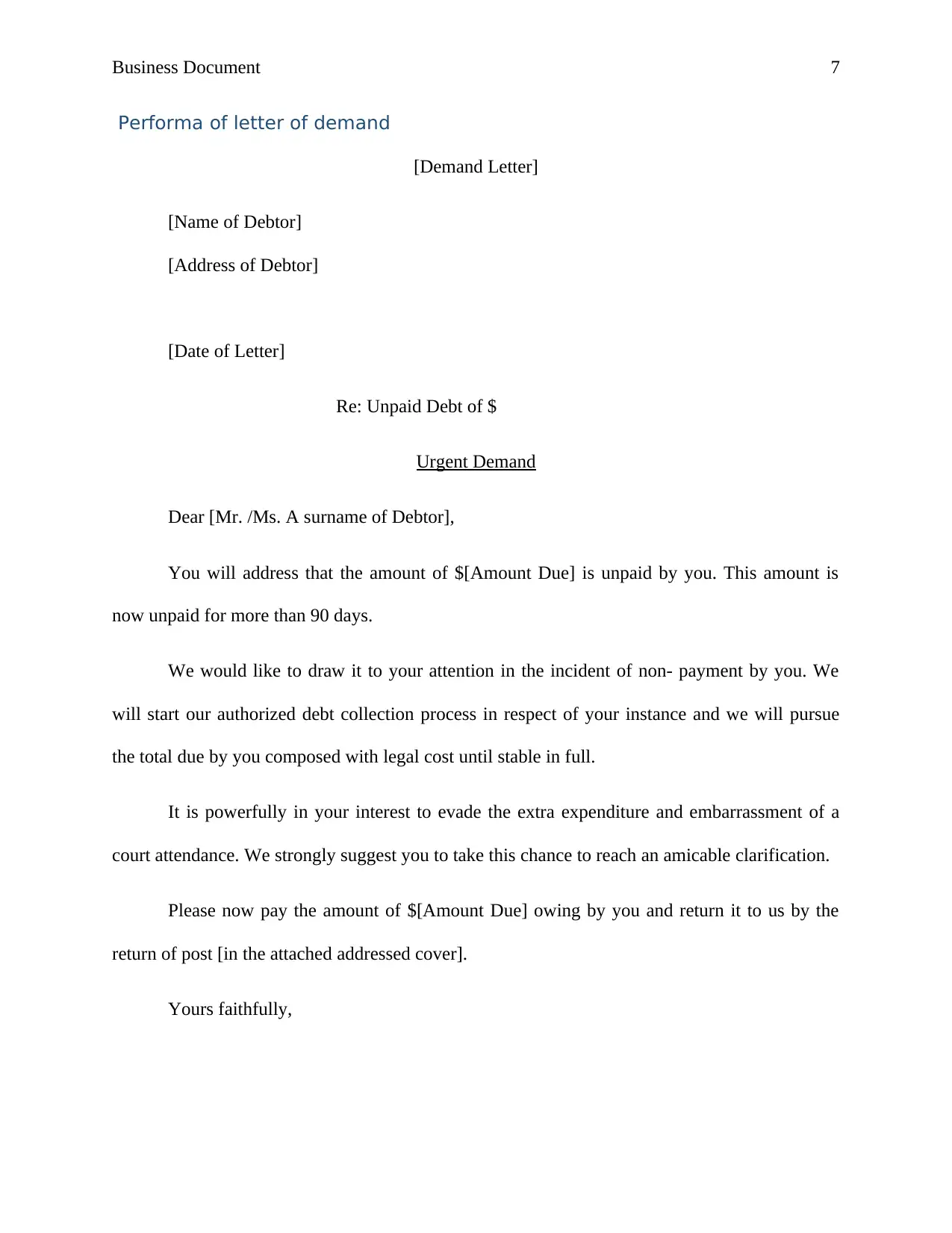
Business Document 7
Performa of letter of demand
[Demand Letter]
[Name of Debtor]
[Address of Debtor]
[Date of Letter]
Re: Unpaid Debt of $
Urgent Demand
Dear [Mr. /Ms. A surname of Debtor],
You will address that the amount of $[Amount Due] is unpaid by you. This amount is
now unpaid for more than 90 days.
We would like to draw it to your attention in the incident of non- payment by you. We
will start our authorized debt collection process in respect of your instance and we will pursue
the total due by you composed with legal cost until stable in full.
It is powerfully in your interest to evade the extra expenditure and embarrassment of a
court attendance. We strongly suggest you to take this chance to reach an amicable clarification.
Please now pay the amount of $[Amount Due] owing by you and return it to us by the
return of post [in the attached addressed cover].
Yours faithfully,
Performa of letter of demand
[Demand Letter]
[Name of Debtor]
[Address of Debtor]
[Date of Letter]
Re: Unpaid Debt of $
Urgent Demand
Dear [Mr. /Ms. A surname of Debtor],
You will address that the amount of $[Amount Due] is unpaid by you. This amount is
now unpaid for more than 90 days.
We would like to draw it to your attention in the incident of non- payment by you. We
will start our authorized debt collection process in respect of your instance and we will pursue
the total due by you composed with legal cost until stable in full.
It is powerfully in your interest to evade the extra expenditure and embarrassment of a
court attendance. We strongly suggest you to take this chance to reach an amicable clarification.
Please now pay the amount of $[Amount Due] owing by you and return it to us by the
return of post [in the attached addressed cover].
Yours faithfully,
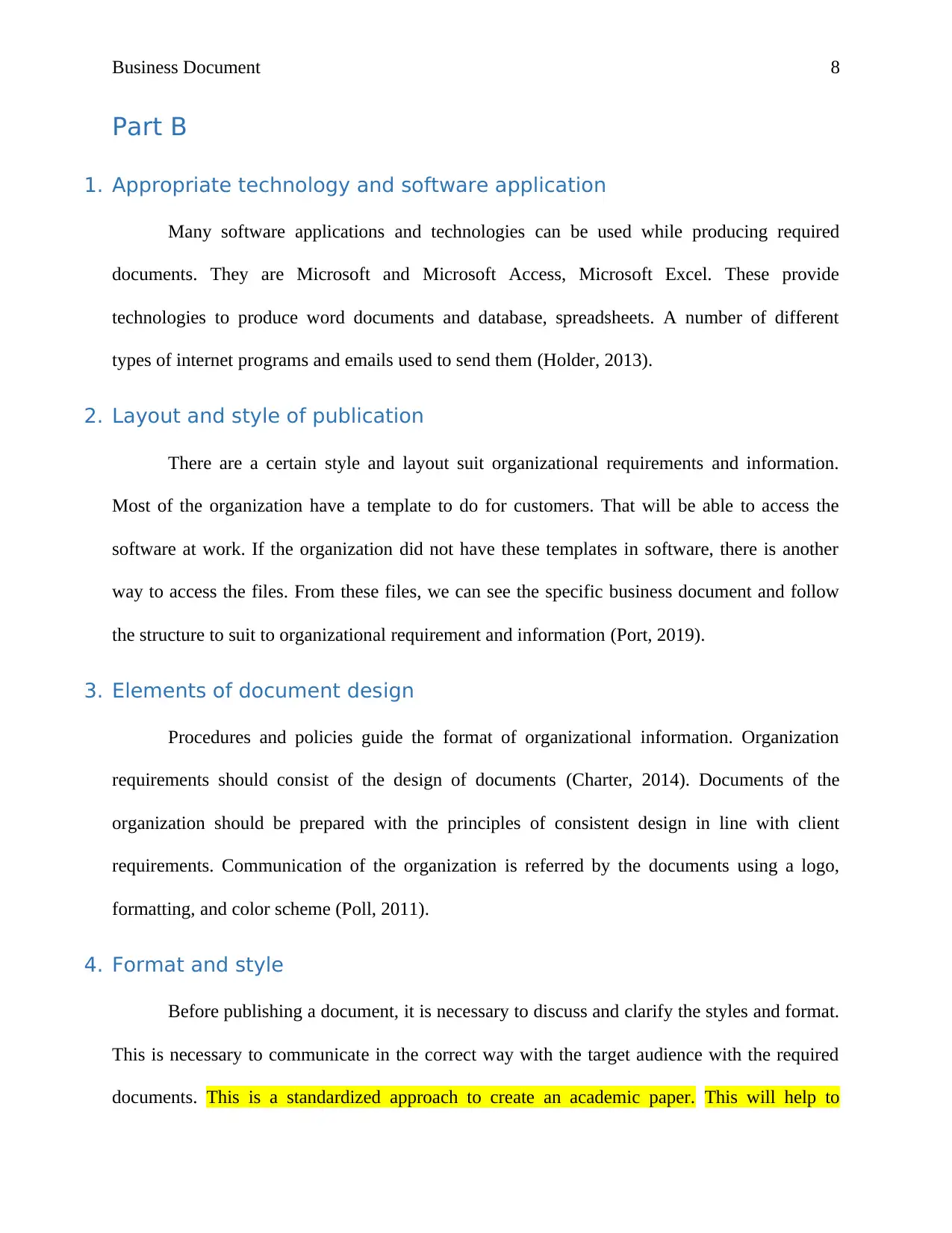
Business Document 8
Part B
1. Appropriate technology and software application
Many software applications and technologies can be used while producing required
documents. They are Microsoft and Microsoft Access, Microsoft Excel. These provide
technologies to produce word documents and database, spreadsheets. A number of different
types of internet programs and emails used to send them (Holder, 2013).
2. Layout and style of publication
There are a certain style and layout suit organizational requirements and information.
Most of the organization have a template to do for customers. That will be able to access the
software at work. If the organization did not have these templates in software, there is another
way to access the files. From these files, we can see the specific business document and follow
the structure to suit to organizational requirement and information (Port, 2019).
3. Elements of document design
Procedures and policies guide the format of organizational information. Organization
requirements should consist of the design of documents (Charter, 2014). Documents of the
organization should be prepared with the principles of consistent design in line with client
requirements. Communication of the organization is referred by the documents using a logo,
formatting, and color scheme (Poll, 2011).
4. Format and style
Before publishing a document, it is necessary to discuss and clarify the styles and format.
This is necessary to communicate in the correct way with the target audience with the required
documents. This is a standardized approach to create an academic paper. This will help to
Part B
1. Appropriate technology and software application
Many software applications and technologies can be used while producing required
documents. They are Microsoft and Microsoft Access, Microsoft Excel. These provide
technologies to produce word documents and database, spreadsheets. A number of different
types of internet programs and emails used to send them (Holder, 2013).
2. Layout and style of publication
There are a certain style and layout suit organizational requirements and information.
Most of the organization have a template to do for customers. That will be able to access the
software at work. If the organization did not have these templates in software, there is another
way to access the files. From these files, we can see the specific business document and follow
the structure to suit to organizational requirement and information (Port, 2019).
3. Elements of document design
Procedures and policies guide the format of organizational information. Organization
requirements should consist of the design of documents (Charter, 2014). Documents of the
organization should be prepared with the principles of consistent design in line with client
requirements. Communication of the organization is referred by the documents using a logo,
formatting, and color scheme (Poll, 2011).
4. Format and style
Before publishing a document, it is necessary to discuss and clarify the styles and format.
This is necessary to communicate in the correct way with the target audience with the required
documents. This is a standardized approach to create an academic paper. This will help to

Business Document 9
perform consistency and navigation. Format and style are necessary to discuss as it makes a
difference in presenting the information (Smith &, 2013).
5. Organizational requirements
Documents such as flyers, newsletters, formal e-mails, and reports are organizational
requirements.
Memorandums and Emails
For convey, information of the organization emails is used. Memorandums used in
specific cases where the requirement of privacy is more.
Letters
These used to communicate outside the office with individuals. Job applicants,
government officials, service providers, and customers are the recipients of letters.
6. The efficient entry of information
The letterhead template of the organization will be used for all formal correspondence.
This provides customers and clients visual identity. This is the most important thing in business.
This avoids unintentional alterations to the layout, contact details, lines of tag, name, and logo of
the organization that is placed in the document tables, header to ensure right positions to each of
the items (Carry, 2014).
7. Functions to ensure consistency of design and layout
To ensure document such as memos and newsletters, forms, reports, and business letters
are consistent in layout and style. A document control procedure and design format applied in the
organization. Standard of quality and desired style reflects communications of an organization
(Henry, 2014). Following are the functions to ensure consistency of layout and design.
perform consistency and navigation. Format and style are necessary to discuss as it makes a
difference in presenting the information (Smith &, 2013).
5. Organizational requirements
Documents such as flyers, newsletters, formal e-mails, and reports are organizational
requirements.
Memorandums and Emails
For convey, information of the organization emails is used. Memorandums used in
specific cases where the requirement of privacy is more.
Letters
These used to communicate outside the office with individuals. Job applicants,
government officials, service providers, and customers are the recipients of letters.
6. The efficient entry of information
The letterhead template of the organization will be used for all formal correspondence.
This provides customers and clients visual identity. This is the most important thing in business.
This avoids unintentional alterations to the layout, contact details, lines of tag, name, and logo of
the organization that is placed in the document tables, header to ensure right positions to each of
the items (Carry, 2014).
7. Functions to ensure consistency of design and layout
To ensure document such as memos and newsletters, forms, reports, and business letters
are consistent in layout and style. A document control procedure and design format applied in the
organization. Standard of quality and desired style reflects communications of an organization
(Henry, 2014). Following are the functions to ensure consistency of layout and design.
Paraphrase This Document
Need a fresh take? Get an instant paraphrase of this document with our AI Paraphraser

Business Document 10
Implement and develop strategies to confirm the use of documents standard.
For documents, the standard text should be developed.
Manage the design and development of a template.
8. Input devices
This is a piece of hardware used to provide data to a computer. This is used for control
and interaction. This allows a computer for processing and inputs the raw data. Following are the
input devices used in computers (Reid, 2017).
Keyboard
This allows the operator to drive command or information to the computer to enter
figures and text.
Mouse
This allows the operator to control the pointer or cursor and open the software, select
items, and open menus by clicking the button of mouse and drag item to move them to folders.
Scanner
This allows the operator to input or capture pictures and text into computer systems.
9. Consequences
The costs of failing to produce a demanded document within the designated timelines are
very serious. The organization depends on the documents to contact relevant personnel, sign
contracts, close deals, and others. Failure to submit the document within the time limit will result
in delays in disclosing the requested information, losing credibility, and damage the organization
(Pierson, 2011).
Implement and develop strategies to confirm the use of documents standard.
For documents, the standard text should be developed.
Manage the design and development of a template.
8. Input devices
This is a piece of hardware used to provide data to a computer. This is used for control
and interaction. This allows a computer for processing and inputs the raw data. Following are the
input devices used in computers (Reid, 2017).
Keyboard
This allows the operator to drive command or information to the computer to enter
figures and text.
Mouse
This allows the operator to control the pointer or cursor and open the software, select
items, and open menus by clicking the button of mouse and drag item to move them to folders.
Scanner
This allows the operator to input or capture pictures and text into computer systems.
9. Consequences
The costs of failing to produce a demanded document within the designated timelines are
very serious. The organization depends on the documents to contact relevant personnel, sign
contracts, close deals, and others. Failure to submit the document within the time limit will result
in delays in disclosing the requested information, losing credibility, and damage the organization
(Pierson, 2011).

Business Document 11
10. Checks
The organization ensures the basic design principles met. This ensures to meet
demonstration and observation in order to competency including underpinning knowledge and
skills. This helps to get the formative feedback. These are a priority for proofreading to ensure
consistency in design, use of styles, checks of formatting, and prior layout (Velarde, 2011).
11. Store a document
Organization prefers to store documents as soft copies. It is important to have a password
that ensures limited accessibility of the documents. Documents of the organization are important
to file and help them to store in a separate location. Document of the organization should be
saved in a simple format to ensure easy storage (Gill, 2017).
12. Document design and production
Style guides, procedure manuals, standard forms of a template to assist in producing a
consistent style of documents, and a manual for recommended software for each function. These
help to identify process information and tasks to perform and support the objectives of
documents. (Warne, 2015).
13. Benefits of proofreading
This is crucial and last stage in academic writing. Proofreading solves the bad phrased,
bad tone, errors of spelling, and errors of grammar in a document. Proofread ensures the quality
of work error free. This helps to sort out the common mistakes. Proofread outlines the repetitive
lines. Proofread ensures beautiful phrases for readable and untestable to definitely gain some
extra marks. This helps to edit simple and complex errors. This avoids the integrity of the
publication.
10. Checks
The organization ensures the basic design principles met. This ensures to meet
demonstration and observation in order to competency including underpinning knowledge and
skills. This helps to get the formative feedback. These are a priority for proofreading to ensure
consistency in design, use of styles, checks of formatting, and prior layout (Velarde, 2011).
11. Store a document
Organization prefers to store documents as soft copies. It is important to have a password
that ensures limited accessibility of the documents. Documents of the organization are important
to file and help them to store in a separate location. Document of the organization should be
saved in a simple format to ensure easy storage (Gill, 2017).
12. Document design and production
Style guides, procedure manuals, standard forms of a template to assist in producing a
consistent style of documents, and a manual for recommended software for each function. These
help to identify process information and tasks to perform and support the objectives of
documents. (Warne, 2015).
13. Benefits of proofreading
This is crucial and last stage in academic writing. Proofreading solves the bad phrased,
bad tone, errors of spelling, and errors of grammar in a document. Proofread ensures the quality
of work error free. This helps to sort out the common mistakes. Proofread outlines the repetitive
lines. Proofread ensures beautiful phrases for readable and untestable to definitely gain some
extra marks. This helps to edit simple and complex errors. This avoids the integrity of the
publication.

Business Document 12
14. Modification
A modification that requires meeting the requirements includes numbering, bullets,
highlights, and bold. Documents of the organization should be saved with meaningful file names,
in case of images; it should be marked as captioned, modification of the images are blurred or
distorted and ensures that bolds and highlights are not too many to make the presence of file
unprofessional (Watson, 2016).
15. Naming and saving
For saving and naming there will be the use of information-rich file names as opposed to
extra-long folder names in order to the identification and streamline the files. Elements orderly
from general to exact details of importance. The same sequence would be used to search the file.
There should be abbreviations used to creating possible concise file names (Negrino, 2014).
16. Printing document
The document of the organization should be looked in the form of the print layout after
everything has been checked and rectified. This presents the appearance of the document for
print. The print dialogue box entails makes setting to print layout and printing paper. The
document is not satisfactory; the setting has to adjust for correctly formatted and error-free.
References
Carry, A. (2014). Information Entry. Data Entry Outsource, 78-98.
14. Modification
A modification that requires meeting the requirements includes numbering, bullets,
highlights, and bold. Documents of the organization should be saved with meaningful file names,
in case of images; it should be marked as captioned, modification of the images are blurred or
distorted and ensures that bolds and highlights are not too many to make the presence of file
unprofessional (Watson, 2016).
15. Naming and saving
For saving and naming there will be the use of information-rich file names as opposed to
extra-long folder names in order to the identification and streamline the files. Elements orderly
from general to exact details of importance. The same sequence would be used to search the file.
There should be abbreviations used to creating possible concise file names (Negrino, 2014).
16. Printing document
The document of the organization should be looked in the form of the print layout after
everything has been checked and rectified. This presents the appearance of the document for
print. The print dialogue box entails makes setting to print layout and printing paper. The
document is not satisfactory; the setting has to adjust for correctly formatted and error-free.
References
Carry, A. (2014). Information Entry. Data Entry Outsource, 78-98.
Secure Best Marks with AI Grader
Need help grading? Try our AI Grader for instant feedback on your assignments.

Business Document 13
Charter, P. (2014). Document Design. Components of Document, 12-26.
Gill, A. (2017, 06 12). Document Storage. Retrieved from Access Record Management:
https://developer.mozilla.org/en-US/docs/Web/API/Document
Henry, M. (2014). Layout Design. Designs, 45-54.
Holder, S. (2013, 05 06). Application Software. Retrieved from Educa:
https://www.educba.com/what-is-application-software-its-types/
Negrino, T. (2014). Peachit. Micro Soft Apps, 06-23.
Pierson, E. (2011, 11 11). Network. Retrieved from Process Excellence Network:
https://www.processexcellencenetwork.com/lean-six-sigma-business-performance/
articles/documenting-the-impact-of-quality-improvement-inte
Poll, A. (2011). Elements of Document Design. Design of Document, 126-624.
Port, H. (2019, 05 06). The layout of Pages. Retrieved from WCRP: https://www.wcrp-
climate.org/cr-publications/wcrp-pub-layout
Reid, M. (2017). Composition of Design. The Fundamental of Design Layout, 89-98.
Smith, D., &. (2013). Style Format. Formatting, 12-21.
Velarde, O. (2011). Documents Check. MDN, 89-96.
Warne, S. (2015, 06 23). Design and Product. Retrieved from SFU:
https://www.sfu.ca/continuing-studies/courses/edit/document-design-and-production-for-
editors.html
Charter, P. (2014). Document Design. Components of Document, 12-26.
Gill, A. (2017, 06 12). Document Storage. Retrieved from Access Record Management:
https://developer.mozilla.org/en-US/docs/Web/API/Document
Henry, M. (2014). Layout Design. Designs, 45-54.
Holder, S. (2013, 05 06). Application Software. Retrieved from Educa:
https://www.educba.com/what-is-application-software-its-types/
Negrino, T. (2014). Peachit. Micro Soft Apps, 06-23.
Pierson, E. (2011, 11 11). Network. Retrieved from Process Excellence Network:
https://www.processexcellencenetwork.com/lean-six-sigma-business-performance/
articles/documenting-the-impact-of-quality-improvement-inte
Poll, A. (2011). Elements of Document Design. Design of Document, 126-624.
Port, H. (2019, 05 06). The layout of Pages. Retrieved from WCRP: https://www.wcrp-
climate.org/cr-publications/wcrp-pub-layout
Reid, M. (2017). Composition of Design. The Fundamental of Design Layout, 89-98.
Smith, D., &. (2013). Style Format. Formatting, 12-21.
Velarde, O. (2011). Documents Check. MDN, 89-96.
Warne, S. (2015, 06 23). Design and Product. Retrieved from SFU:
https://www.sfu.ca/continuing-studies/courses/edit/document-design-and-production-for-
editors.html

Business Document 14
Watson, R. (2016, 08 07). Modification. Retrieved from Word Reference:
https://forum.wordreference.com/threads/what-is-modification
Watson, R. (2016, 08 07). Modification. Retrieved from Word Reference:
https://forum.wordreference.com/threads/what-is-modification
1 out of 15
Related Documents
Your All-in-One AI-Powered Toolkit for Academic Success.
+13062052269
info@desklib.com
Available 24*7 on WhatsApp / Email
![[object Object]](/_next/static/media/star-bottom.7253800d.svg)
Unlock your academic potential
© 2024 | Zucol Services PVT LTD | All rights reserved.




